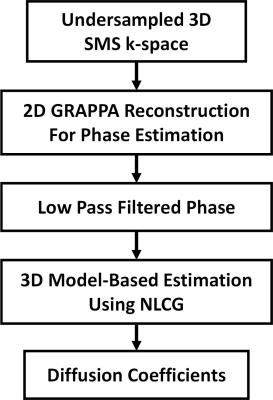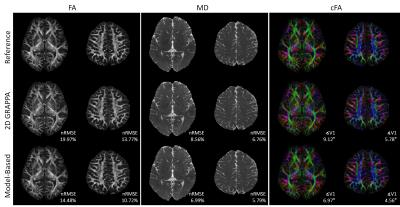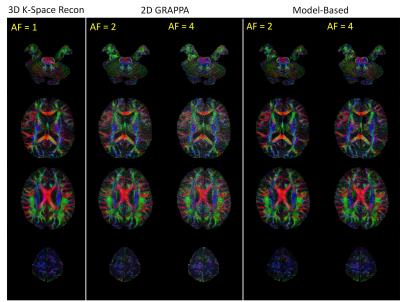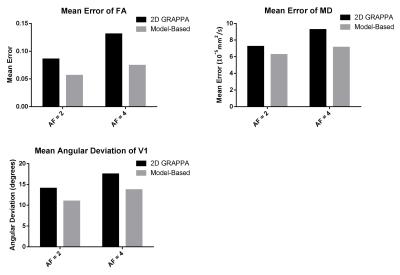3511
Model-Based Reconstruction for Undersampled High Resolution Diffusion Tensor Imaging Combined with Simultaneous Multi-Slice Acquisitions1Center for Biomedical Imaging Research, Department of Biomedical Engineering, School of Medicine, Tsinghua University, Beijing, People's Republic of China, 2Harvard-MIT Health Sciences and Technology, MIT, Cambridge, MA, United States, 3Department of Electronic Engineering, Tsinghua University, Beijing, People's Republic of China, 4Vascular Imaging Laboratory, Department of Radiology, University of Washington, Seattle, WA, United States
Synopsis
Multi-shot interleaved EPI is an effective method to acquire high-resolution and less distorted diffusion weighted images, but with relatively low acquisition efficiency, especially for diffusion tensor imaging. Here, a novel model-based reconstruction is proposed for accelerated multi-shot diffusion imaging with simultaneous multi-slice (SMS) and partially parallel imaging (PPI). The method can directly estimate diffusion tensors from the undersampled k-space data, by integrating information of all shots and diffusion encoding directions. Simulation and in-vivo experiment demonstrated that the proposed method can achieve higher acceleration efficiency and improved accuracy in tensor estimation compared with conventional 2D GRAPPA.
Purpose
Multi-shot EPI, such as interleaved EPI (iEPI) combined with phase correction methods1-3 can provide high-resolution diffusion images with reduced distortion. However, multiple excitations and diffusion-encoding directions prolong the acquisition time, which may impede its clinical application. In-plane partially parallel imaging (PPI)4,5 can reduce the number of excitations but result in severe SNR loss, especially at high acceleration factors. Simultaneous multi-slice (SMS)6 acquisition is another technique to reduce the volume scan time by a factor of MB, but without $$$\sqrt{MB}$$$ SNR penalty. In another abstract, we have demonstrated the effectiveness of model-based method for iEPI acceleration with in-plane PPI. In this study, we proposed a model-based reconstruction for high resolution DTI acceleration using both SMS and in-plane PPI with improved accuracy and SNR.Methods
As reported, the k-space from SMS acquisition can be described as an undersampled 3D k-space for more straightforward reconstruction7. Here, we extend the model-based reconstruction to SMS imaging, and the diffusion tensor $$$D$$$ can be estimated by solving the following optimization problem:$$arg\min \limits_{D} \frac{1}{2}\lVert\tilde{K}-FI(D)\rVert_2^2+\lambda\lVert TV(D)\rVert_1$$where $$$I$$$ are the DW images of all shots and directions synthesized by multiplying non-diffusion-weighted image with phase variation and diffusion contrast. $$$F$$$ is the 3D Fourier Transform operator and $$$\tilde{K}$$$ is the undersampled SMS 3D k-space. The first term is data fidelity and the second is total variation (TV) constraint. $$$\lambda$$$ is a parameter to control the contribution of TV. Figure 1 illustrates the reconstruction procedure of the proposed method. First, undersampled 3D k-space from SMS is roughly reconstructed by 2D GRAPPA. Then, the image phase of each shot is estimated and filtered by Tukey windowing. Nonlinear conjugate gradient (NLCG) algorithm is then adopted to solve the optimization problem iteratively to reconstruct the multiple slice tensors $$$D$$$. In model-based reconstruction, direct estimation of tensors using data from all directions reduces the number of unknowns than reconstruction of all DW images8. In addition, full-sampled non-diffusion-weighed image and total variation constraint further improve the accuracy of estimation.
Simulation: DTI datasets were simulated to evaluate the proposed method quantitatively. A DTI scan was performed to acquire non-diffusion-weighted images and diffusion tensors. The $$$D$$$ matrices of two slices were used to simulate the SMS data. Non-diffusion-weighted images were duplicated first and the diffusion contrast was generated using $$$D$$$ to simulate multi-direction diffusion-encoded images. Spatially varying random phases (2nd-order) and Gaussian noise (SNR=5) were also included. To mimic the undersampled 3D k-space using SMS and in-plane PPI, the synthesized images were first transformed to 3D k-space and then manually undersampled. Here, the acceleration factors of SMS and in-plane PPI were denoted by MB and AF, respectively. In this test, 32-direction 32-channel DTI data were simulated with AF = 3 and MB = 2. The performance of the proposed method was compared with conventional 2D GRAPPA9.
In-vivo experiment: In vivo SMS accelerated DTI data were acquired with a 4-shot iEPI sequence with 2D navigators, using a 32-channel head coil. The scan parameters were: MB = 2, FOV = 216×216 mm2, slice thickness = 4 mm, TR/TE = 3000/75 ms, in-plane image resolution = 1×1 mm2, number of diffusion directions = 16, b value = 800 s/mm2, NSA = 1, partial Fourier factor = 0.7. First, the fully sampled 4-shot data with navigators were reconstructed by a SMS 3D k-space method10 as a reference. Then the performance of the proposed method and 2D GRAPPA were compared at two different in-plane acceleration factors: AF=2 (using image-echo data from 2 shots) and AF=4 (using image-echo data from only 1 shot).
Results
Figure 2 shows results reconstructed by 2D GRAPPA and the proposed model-based method from the simulation with AF=3. The proposed method performed better than 2D GRAPPA by showing more accurate images which are closer to the references. Meanwhile, it gave less errors in the three parameters evaluated. The in-vivo results are shown in Figure 3 and Figure 4. In Figure 3, the reconstructed color-coded FA (cFA) maps by the proposed method are better than 2D GRAPPA with improved SNR. More quantitative results are shown in Figure 4. The errors were calculated by comparing with the reference generated from the fully sampled data. The error in the proposed method at AF=4 is even lower than 2D GRAPPA at AF=2, which demonstrates the superiority of the model-based reconstruction.Discussion and Conclusion
The simulation and in-vivo experiment preliminarily validated that the proposed model-based reconstruction can provide accurate estimation of the tensors for SMS and in-plane PPI accelerated multi-shot DTI imaging. Thus, high scan efficiency can be achieved in high resolution DTI while maintaining accuracy and SNR.Acknowledgements
No acknowledgement found.References
1. Dong Z, Wang F, Ma X, Dai E, Zhang Z, Guo H. A Robust Reconstruction Method for High Resolution Multishot DWI: SPIRiT-based SYMPHONY. In Proc Intl Soc Mag Reson Med 2016, p 3019.
2. Ma X, Zhang Z, Dai E, Guo H. Improved multi-shot diffusion imaging using GRAPPA with a compact kernel. NeuroImage 2016.
3. Zhang Z, Huang F, Ma X, Xie S, Guo H. Self-feeding MUSE: a robust method for high resolution diffusion imaging using interleaved EPI. NeuroImage 2015;105:552-560.
4. Pruessmann KP, Weiger M, Scheidegger MB, Boesiger P. SENSE: sensitivity encoding for fast MRI. Magn Reson Med,1999;42(5):952-962.
5. Griswold MA, Jakob PM, Heidemann RM, Nittka M, Jellus V, Wang J, Kiefer B, Haase A. Generalized autocalibrating partially parallel acquisitions (GRAPPA). Magn Reson Med, 2002;47(6):1202-1210.
6. Setsompop K, Gagoski BA, Polimeni JR, Witzel T, Wedeen VJ, Wald LL. Blipped-controlled aliasing in parallel imaging for simultaneous multislice echo planar imaging with reduced g-factor penalty. Magn Reson Med, 2012;67(5):1210-1224.
7. Zahneisen B, Poser BA, Ernst T, Stenger VA. Three-dimensional Fourier encoding of simultaneously excited slices: generalized acquisition and reconstruction framework. Magn Reson Med, 2014;71(6):2071-2081.
8. Knoll F, Raya JG, Halloran RO, Baete S, Sigmund E, Bammer R, Block T, Otazo R, Sodickson DK. A model-based reconstruction for undersampled radial spin-echo DTI with variational penalties on the diffusion tensor. NMR in biomedicine 2015;28(3):353-366.
9. Blaimer M, Breuer FA, Mueller M, Seiberlich N, Ebel D, Heidemann RM, Griswold MA, Jakob PM. 2D-GRAPPA-operator for faster 3D parallel MRI. Magn Reson Med, 2006;56(6):1359-1364.
10. Dai E, Ma X, Zhang Z, Yuan C, Guo H. Simultaneous multislice accelerated interleaved EPI DWI using generalized blipped-CAIPI acquisition and 3D K-space reconstruction. Magn Reson Med, 2016.
Figures



